The Friends of the Wildflower Garden, Inc.
Plants of the Eloise Butler Wildflower Garden
The oldest public wildflower garden in the United States

Common Name
Jerusalem Artichoke (Earth Apple)
Scientific Name
Helianthus tuberosus L.
Plant Family
Aster (Asteraceae)
Garden Location
Upland
Prime Season
Late Summer to Early Autumn Flowering
Jerusalem Artichoke is a native erect perennial forb, growing on stout stems from 4 to 10 feet high. Stems have stiff hair, are usually green with some reddish tinges in partial sun locations, more reddish in very sunny spots; they are usually unbranched except sometimes branched in the floral array.
The leaves are opposite on the lower stem and alternate in the upper part, at least the very upper section, while some plants are alternate in the upper 1/3. The shape is ovate to ovate-oblong with 3 prominent nerves near the base; the base can be narrowed, to truncate, with a long partially winged stalk on the lower leaves, shorter stalks (up to 1/2 inch long) on the uppers. Leaves can be up to 10 inches long and are generally 2x as long as wide. They are rough on top, hairy and gland-dotted on the underside, with coarse teeth on the margins.
The floral array can have 3 to 15 heads in large branched clusters rising from the upper stem.
The flowers are composite, about 2 to 4 inches wide, consisting of an outer ring of 10 to 20 yellow ray florets with rays 25-40 mm long, which are not fertile and an inner disc of 60+ bisexual fertile disc florets whose corollas are tubular with yellow triangular tip lobes. The five stamens have dark brown to black anthers and there is a branched style; stamens tightly surround the style and when the floret opens, both are exserted from the corolla. The flower head is hemispheric in shape with the outside composed of 22 to 35 phyllaries, in several series, that are dark green to blackish (drying nearly black), lanceolate in shape, with bases appressed and the pointed tips spreading to sometimes reflexed. The outer surface can be finely hairy to gland-dotted.
Seed: Mature flowers produce a dry deltate shaped gray to brownish cypsela with a pair of awl-shaped awns on the top, which quickly fall away, and with fine hair on the wider end of the seed. Seeds of Helianthus usually require about 30 days of cold stratification for germination.
Habitat: Jerusalem Artichoke will be found along roadsides, field edges and other waste areas where it has full to partial sun and moisture. It is not drought tolerant. It grows from a fibrous and rhizomatous root system that produces tubers in late summer. It can become an aggressive pest.
Names: The genus Helianthus is from two Greek words, helios for 'sun' and anthos for 'flower'. The species tuberosus refers to the tubers produced by the root system. In 1803 Michaux assigned the name Helianthus tomentosus but that name is not accepted today.
The author name for the plant classification, from 1753 - 'L.' refers to Carl Linnaeus (1707-1778), Swedish botanist and the developer of the binomial nomenclature of modern taxonomy. The common name is thought to be derived as follows: The tubers resemble those of artichoke. Fernald reports (Ref. #6) that the Native Americans introduced the tubers to the colonists who sent them back to Europe where they became popular in the Mediterranean area, the Spanish calling them girasol and the Italians girasole, which the English transliterated into 'Jerusalem'.
Comparisons: Jerusalem Artichoke is a tall sunflower and can be distinguished from other tall sunflowers by the longer winged leaf stalks and hairy stem plus the dark green to blackish phyllaries of the flower head.
The other species of Helianthus found in the Garden are: H. hirsutus, Stiff-haired Sunflower; H. pauciflorus ssp. pauciflorus, Stiff Sunflower; H. strumosus, Pale-leaf Woodland Sunflower; and Helianthus giganteus, Giant Sunflower.

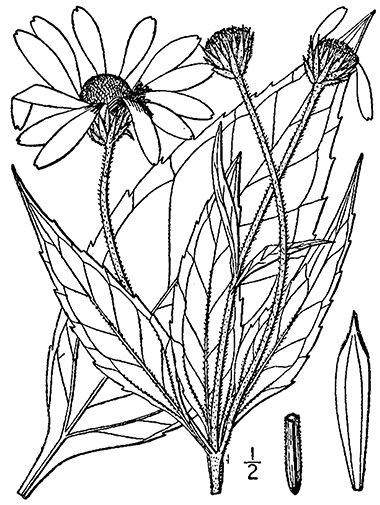
Above: Plants are tall - 4 to 10 feet with 3 to 15 heads in the floral array. Leaves alternate near the top, opposite lower. Drawing from Britton, N.L., and A. Brown. 1913. An illustrated flora of the northern United States, Canada and the British Possessions. 3 vols. Charles Scribner's Sons, New York.
Below: The flower has 10 to 20 outer infertile yellow ray florets, surrounding the 60+ fertile disc florets which open from the outer edge toward the center.

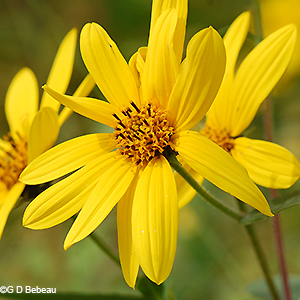
Below: 1st photo - The disc florets have yellow corollas with 5 spreading lobes when open, stamens with dark anthers and a branched style. 2nd photo - Stems, leaf stalks and leaves have short stiff hairs. Stalks are usually reddish when they receive lots of sun, otherwise greenish.
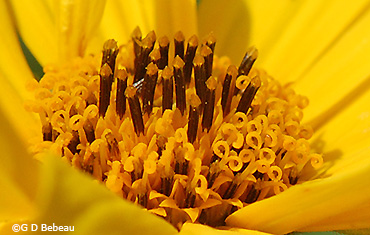
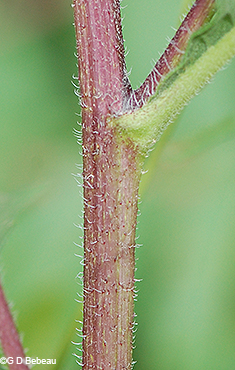
Below: Two views of the Phyllaries: The flower head has 22 to 35 phyllaries, in several series, which are dark green to blackish, with pointed tips that are somewhat spreading, with the outer surface rough with stiff hair.
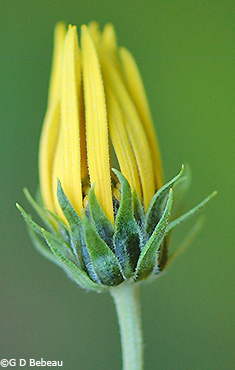
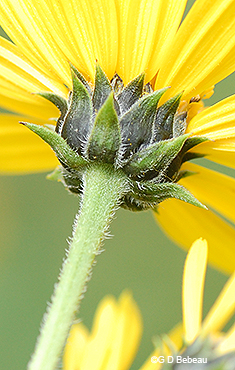
Below: 1st and 2nd photos - 2 leaf variations showing the upper side of the leaf. Leaves are rough, pointed tip, base tapered to truncate with a wing on the stalk. 3rd photo - The undersurface of the leaf is covered with dense short hair; longer hair on the veins.
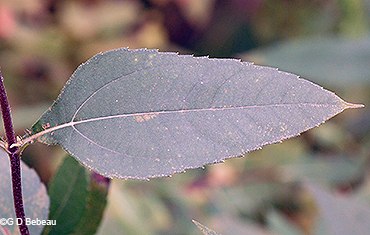
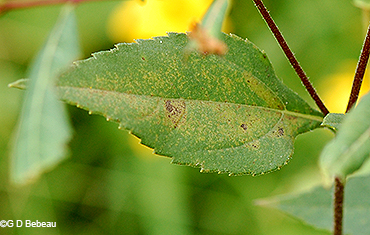
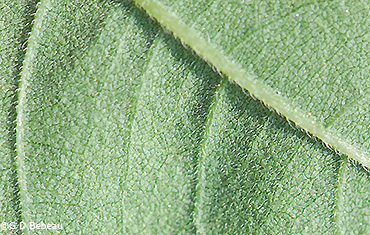
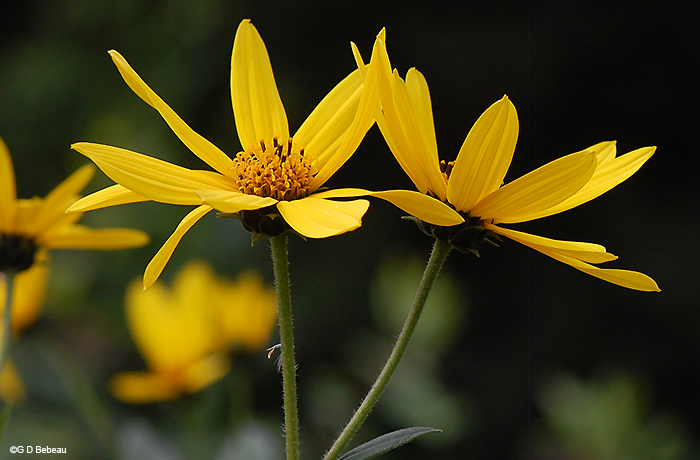
Notes: Jerusalem Artichoke is considered indigenous to the area of the Garden. Eloise Butler also planted it in 1909, '13 and '19. Martha Crone planted it in 1944, '47, '52, '53, '54, and '55. Within Minnesota it is found in the majority of counties with the exceptions widely scattered. There are a total of 12 species of Helianthus native to Minnesota. It is widespread in North America being found in all the states except Nevada, Arizona and New Mexico and known in Canada from Saskatchewan eastward except for Labrador and Newfoundland.
Varieties: Some references break this species into two varieties. H. tuberosus var. subcanescens is said to have the alternate leaves just at the very top and the underside of the leaf to have more fine hair than var. tuberosus which also has the alternate leaves in the upper 1/3 of the plant. The plants pictured here would be of the first variety, although most authorities, such as Flora of North America, USDA, and the Minnesota authorities do not recognize separate varieties of H. tuberosus viewing them instead as variations within the species.
Former Curator Martha Crone wrote: "The Jerusalem Artichoke is not an artichoke, neither did it come from Jerusalem. It is a native Sunflower with a tuberous root that was extensively used by the Indians. The nutritious tuber is still being used for food and makes palatable salad having a flavor of celery root or salsify. Other names for it are Canada potato, Earth apple, Girasole and Topinambour. Its rough stems grow six to twelve feet tall, the large leaves are rough as sandpaper. The many attractive sunflower like blossoms three and one half inches in diameter remaining in bloom several weeks and well up to frost." The Fringed Gentian™, Vol. 1 #4, October 1953.
Other lore and uses: Fernald (Ref. #6) notes that the flesh of the tubers is watery and sweet, palatable to some, not to others. They were often pureed and baked with oil, or boiled. When they arrived in Europe they became so popular and common in London that "even the vulgar began to despise them." The plant was widely cultivated for the tubers, which resulted in the plant appearing in many places where it was not found in the wild state. Densmore (Ref. #5) reports that the Minnesota Chippewa ate them raw like a radish. It is considered starch-less with fewer calories than the Irish Potato and is more digestible.
Return to -- Site Plan/Archive Index --or-- List of Common Plant Names -- or -- List of Scientific Names -- or --Home Page - - - Back to top.
References: Plant characteristics are generally from sources 1A, 32, W2, W3, W7 & W8 plus others as specifically applied. Distribution principally from W1, W2 and 28C. Planting history generally from 1, 4 & 4a. Other sources by specific reference. See Reference List for details.
 Identification booklet for most of the flowering forbs and small flowering shrubs of the Eloise Butler Wildflower Garden. Details Here.
Identification booklet for most of the flowering forbs and small flowering shrubs of the Eloise Butler Wildflower Garden. Details Here.
©2013
Friends of the Wildflower Garden, Inc. Text and photos are by G. D. Bebeau unless otherwise credited. "www.friendsofeloisebutler.org"
062720